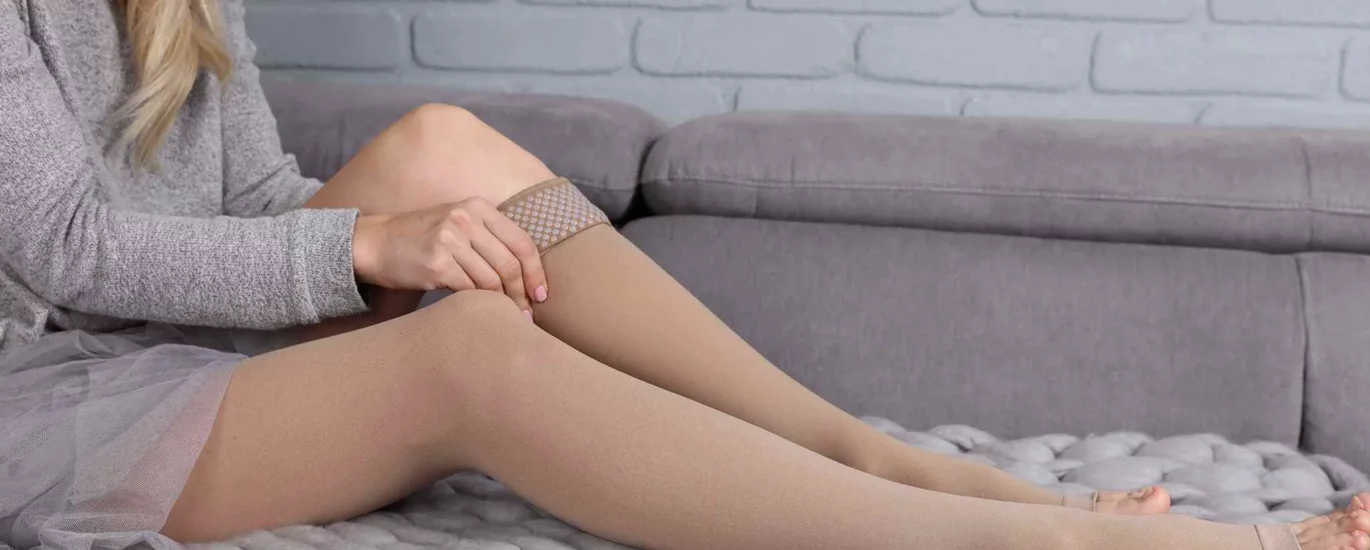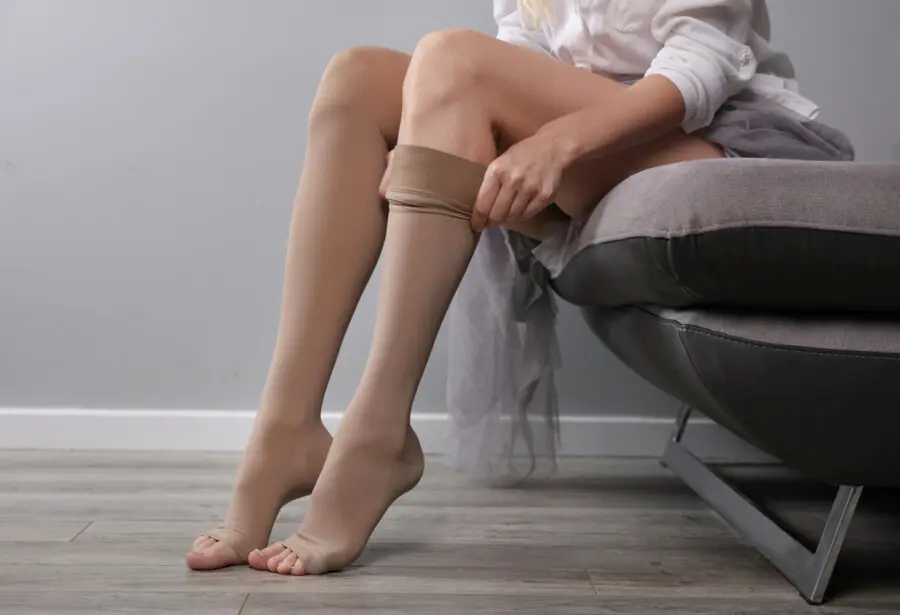


Compression stockings are special socks or stockings that gently squeeze your legs, ankles, and feet. They are made of stretchy materials and come in different lengths, like knee-high or thigh-high. The main purpose of compression stockings is to help improve blood flow in your legs. These stockings have become huge popular and many people use them for different reasons. Originally, they were created to treat medical conditions like problems with leg veins, blood clots, or swelling caused by poor circulation. But now, more and more people are using compression stockings to relieve discomfort, swelling, and tiredness in their legs. Even athletes and people who travel a lot use them to boost circulation and reduce the risk of blood clots when they have to sit or stand for long periods. However, it’s important to know that there can be some side effects of wearing compression stockings.
Just like any medical treatment, they may cause certain problems for some people. That’s why it is very important to understand the possible side effects before you start using them. By learning about these potential side effects, you can make informed choices about whether wearing compression stockings are right for you.
Compression stockings are special socks or stockings that put gentle pressure on your legs, ankles, and feet. Their main job is to help improve the flow of blood in your legs. They work by squeezing your legs more at the bottom and less as they go up. In stores, you can find different kinds of compression stockings to choose from. Here are some common types:
These stockings have the strongest pressure at the ankles and the pressure gradually gets lighter as it goes up your legs. This helps push the blood up towards your heart and improves how well your blood circulates.
These stockings are made to prevent blood clots, especially in people who are not able to move around much. They apply an even amount of pressure to your legs to help the blood flow better and reduce the risk of blood clots.
These stockings are made for pregnant women who have swelling and discomfort in their legs during pregnancy. They have gentle pressure to support good blood flow and lessen tiredness in the legs.
These stockings are popular among athletes and active people. They are designed to boost blood flow, reduce muscle vibrations, and improve performance during physical activities. Some of them have special areas that provide extra support to certain muscles.
Compression stockings also come in different levels of pressure. This means some stockings squeeze your legs more than others. Here are the common pressure levels:
These stockings have the lightest pressure and are good for preventing minor leg discomfort or swelling when you sit or stand for a long time.
These stockings have a medium amount of pressure and are often recommended for people with mild to moderate swelling, varicose veins, or spider veins. They are also helpful for preventing blood clots during long trips.
These stockings have a higher pressure and are usually prescribed for people with moderate to severe vein problems, like varicose veins. They work well to reduce swelling and improve blood flow.
These stockings have the strongest pressure and are usually prescribed for people with serious vein issues, lymphedema, or chronic leg ulcers. They need to be fitted properly and used under the guidance of a medical professional.
Compression stockings have many positive effects and can help different people in different ways. Let’s look at some common benefits:
Compression stockings can be really helpful for people with varicose veins, which are swollen and twisted veins that often appear in the legs. These stockings put gentle pressure on the legs, which improves blood flow and reduces swelling and discomfort. They can also be good for managing edema, which is when your legs, ankles, or feet get swollen because of fluid buildup.
If you play sports or are active, wearing compression stockings during your activities can be beneficial. They can improve blood circulation, which means your muscles get more oxygen and nutrients. This can help you perform better, feel less tired, and recover faster after exercising. Compression stockings can also reduce muscle vibrations, which might help prevent muscle soreness and injuries. For people who sit or stand for long periods, like office workers or travelers, these stockings can reduce leg discomfort, swelling, and fatigue by promoting better blood flow.
Compression stockings can be useful in reducing the chances of getting blood clots, especially during long trips or after surgery. When you stay seated or still for a long time, blood flow in your legs can slow down and increase the risk of blood clots. Compression stockings put pressure on the veins, which helps keep the blood flowing well and lowers the risk of problems like deep vein thrombosis (DVT) or other circulation issues.
Pregnant women often experience leg swelling, discomfort, and tiredness due to the extra pressure on their veins and hormonal changes. Maternity compression stockings give gentle pressure to the legs, which can reduce swelling and improve blood flow. They can help pregnant women feel more comfortable and stay active during their pregnancy.
Remember, compression stockings might not be suitable for everyone. It’s a good idea to talk to a healthcare professional to see if they are right for you. They can give you advice on what type and level of compression stockings would be best for your specific needs.
While wearing compression stockings can be helpful, however, it is important to know that they might have some side effects for certain people. Here are some potential side effects of wearing compression stockings:

Most people wearing compression stockings don’t experience these severe side effects. However, it’s important to pay attention to any discomfort or changes you feel while wearing them. If you have any concerns or if something doesn’t feel right, stop using the stockings and talk to a doctor for advice.
Several things can affect the side effects of wearing compression stockings. It’s important to understand these factors to use them safely and effectively. Let’s break them down in simple terms:
Getting the right fit and size for your compression stockings is crucial to minimize side effects. If they are too tight, they can cause discomfort and restrict blood flow. If they are too loose, they may not work well. Make sure to follow the instructions for sizing or ask a doctor for help to ensure the stockings fit your legs properly.
The length of time and frequency of wearing compression stockings can affect side effects. It’s usually recommended to wear them during the day and take them off at night to give your legs a break. Wearing them for too long without breaks can lead to discomfort or other issues. Also, wearing them longer than advised or using higher compression levels than necessary can increase the chances of problems. Following the recommended wearing schedule and guidelines can help prevent side effects.
Remember, finding the right fit, following the recommended wearing instructions, and seeking advice from a healthcare professional are important for minimizing side effects and getting the most out of compression stockings. Everyone is different, so personalized care and open communication with doctor will help you use compression stockings safely and effectively.
Compression stockings can be helpful for improving blood circulation and managing various conditions. However, it’s important to be aware of possible side effects. By understanding these side effects and taking precautions, you can use compression stockings safely. Make sure your compression stockings fit well and feel comfortable. Ask a healthcare professional for help in choosing the right size and level of compression. Follow the recommended schedule for wearing them and take breaks to let your legs rest.
If you have diabetes or arterial disease, talk to your doctor before using compression stockings. They can give you advice specific to your condition and help you use them safely. Stay in touch with your doctor and let them know if you have any concerns. Watch for any discomfort or irritation while wearing compression stockings. If you have persistent symptoms, seek medical attention promptly.
Read Also: